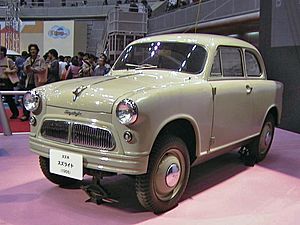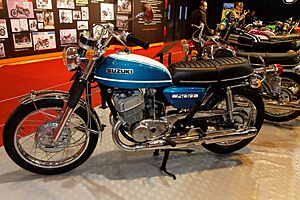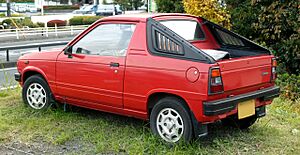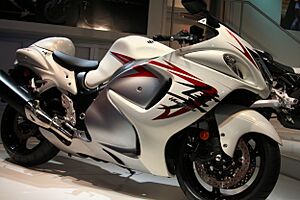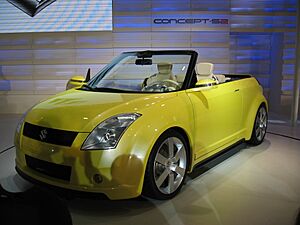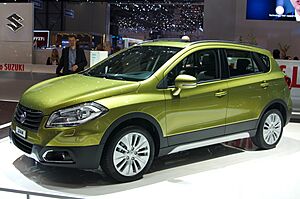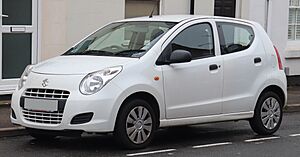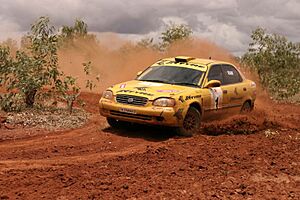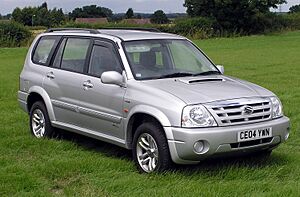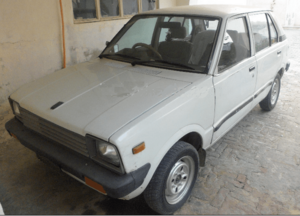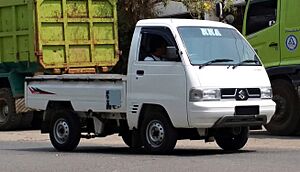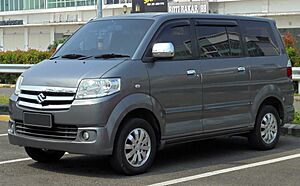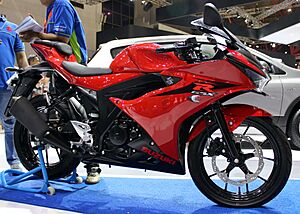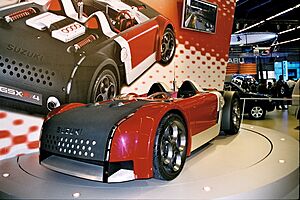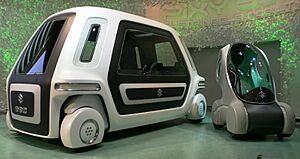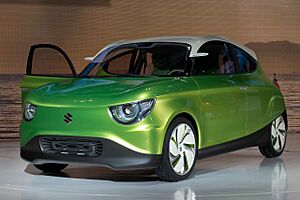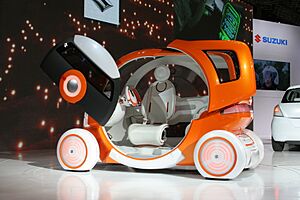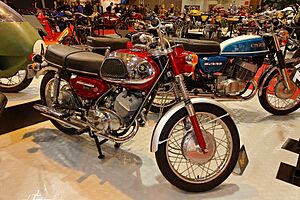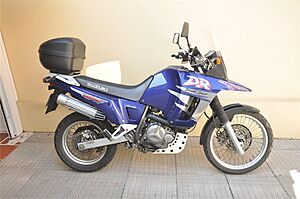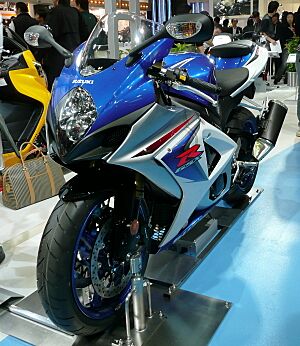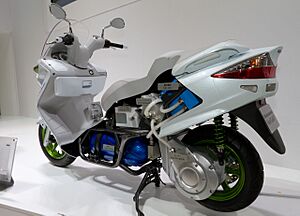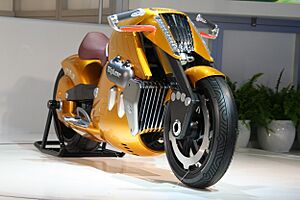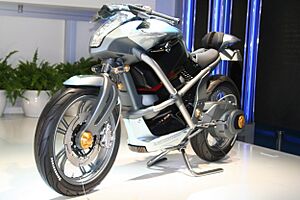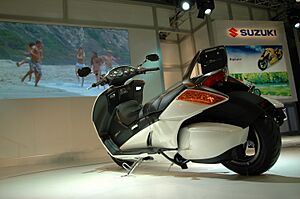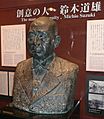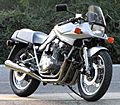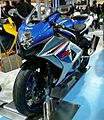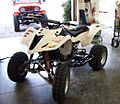Suzuki facts for kids

Suzuki's logo since 1958
|
|
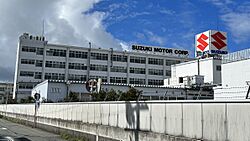
|
|
|
Native name
|
スズキ株式会社
|
|---|---|
|
Romanized name
|
Suzuki Kabushiki-Gaisha |
| Public (K.K.) | |
| Traded as | TYO: 7269 |
| Industry | Automotive |
| Founded | October 1909 (as Suzuki Loom Works) |
| Founder | Michio Suzuki |
| Headquarters | Takatsuka, Minami-ku, Hamamatsu,
,
Japan
|
|
Area served
|
Worldwide |
|
Key people
|
Osamu Suzuki (chairman) (acting) Yasuhito Harayama (vice chairman) Toshihiro Suzuki (President) |
| Products | Automobiles, engines, motorcycles, ATVs, outboard motors |
|
Production output
|
|
| Revenue | |
|
Operating income
|
|
| Total assets | |
| Total equity | |
| Owners |
|
|
Number of employees
|
69,193 (2021) |
| Subsidiaries |
|
Suzuki Motor Corporation is a big Japanese company that makes many different kinds of vehicles. It's based in Hamamatsu, Shizuoka, Japan. Suzuki is famous for making cars, motorcycles, all-terrain vehicles (ATVs), and even boat engines.
In 2016, Suzuki was the eleventh largest car maker in the world. The company has over 45,000 employees and factories in 23 countries. They also have distributors in 192 countries, selling their products all over the globe.
Contents
- Suzuki's Early Days: From Looms to Motors
- Suzuki's Comeback: Motorcycles and Cars
- Suzuki's Leaders and Key Moments
- Suzuki Around the World: Subsidiaries
- Suzuki's Production Facilities Around the World
- Suzuki Automobiles
- Suzuki Motorcycles
- Suzuki All-Terrain Vehicles (ATVs)
- Suzuki's Sports Sponsorships
- Images for kids
- See also
Suzuki's Early Days: From Looms to Motors
The Suzuki company started in 1909. A man named Michio Suzuki founded it in a small Japanese village. Back then, it was called Suzuki Loom Works. They made weaving looms for Japan's busy silk industry.
Michio Suzuki was very good at inventing. In 1929, he created a new type of weaving machine that was even sold to other countries. For the first 30 years, the company focused only on these machines.
But Michio Suzuki wanted to make more than just looms. He saw that people needed small, affordable cars. So, in 1937, he started working on a car project. Within two years, Suzuki had built several test cars. These early cars had a new type of engine that was cooled by liquid.
However, World War II stopped these plans. The government said that passenger cars were not important during the war. After the war, Suzuki went back to making looms. But the cotton market soon crashed, causing problems for the company.
Suzuki's Comeback: Motorcycles and Cars
Facing challenges, Suzuki decided to return to making vehicles. After the war, many Japanese people needed cheap and reliable ways to get around. Other companies were making small engines that could be attached to bicycles.
Suzuki's first two-wheeled vehicle was a motorized bicycle called the "Power Free." It came out in 1952. It was designed to be cheap and easy to fix. The Power Free had a small 36 cc engine. It had a clever gear system that let the rider pedal with the engine's help, pedal without it, or just use the engine alone. The government even gave Suzuki money to keep working on motorcycle designs.
By 1954, Suzuki was making 6,000 motorcycles every month! The company officially changed its name to Suzuki Motor Co., Ltd. After their motorcycle success, Suzuki made an even more popular car: the 1955 Suzuki Suzulight. The Suzulight was special because it had front-wheel drive and other advanced features that weren't common in cars until much later.
From 2009 to 2015, Volkswagen owned a part of Suzuki. But this partnership didn't last. Suzuki felt Volkswagen wasn't sharing technology as promised. In the end, a court ordered Volkswagen to sell its shares back to Suzuki. Suzuki paid $3.8 billion to buy back its shares in 2015.
Suzuki's Leaders and Key Moments
The company was started by Michio Suzuki. Today, Osamu Suzuki is the chairman. He is the fourth "adopted son-in-law" in a row to lead the company. Osamu Suzuki, who is 91 years old, plans to retire in June 2021 and hand over leadership to his son, Toshihiro.
Suzuki started by making looms in 1909. Michio Suzuki wanted to make better looms. His dream of making cars was put on hold by World War II. Before making four-stroke engines, Suzuki was known for its two-stroke engines, used in motorcycles and early cars.
After the war, Suzuki made a motorized bicycle. Later, the company became famous for powerful motorcycles like the Hayabusa and GSX-R models. They also made the QuadRunner ATV. Even after making its first car in 1955, Suzuki didn't have a separate car division until 1961. Today, Suzuki is one of the world's biggest car makers. They are a major brand in places like Japan and India.
Important Dates in Suzuki's History
1909-1960: The Early Years
- 1909: Michio Suzuki starts Suzuki Loom Works in Hamamatsu, Japan.
- 1920: The company becomes Suzuki Loom Manufacturing Co.
- 1937: Suzuki begins planning to make small cars.
- 1945: Plants close due to war damage.
- 1949: Suzuki lists its shares on major stock exchanges in Japan.
- 1952: The "Power Free" motorized bicycle is sold.
- 1954: The company changes its name to Suzuki Motor Co., Ltd.
- 1955: Suzuki introduces the Suzulight car, a small front-wheel drive vehicle.
- 1958: The famous 'S' mark is adopted as the company logo.
- 1959: A typhoon destroys Suzuki's assembly plant.
- 1960: A new, modern assembly plant is finished.
1961-1969: Racing and New Products
- 1961: The loom division becomes a separate company.
- 1962: Suzuki wins its first major motorcycle race at the Isle of Man TT.
- 1963: Mitsuo Itoh becomes the first Japanese rider to win the Isle of Man TT. Suzuki opens a branch in Los Angeles, USA.
- 1965: Suzuki starts making outboard marine engines. They also introduce the Fronte 800 car.
- 1967: The first motorcycle assembly plant outside Japan opens in Thailand.
- 1968: Suzuki introduces the T500 motorcycle, known as the largest two-stroke engine at the time.
1970-1980: Off-Road and Global Growth
- 1970: The LJ10, Suzuki's first mass-produced 4x4 mini-car, is released.
- 1971: The GT750 motorcycle debuts with a liquid-cooled engine. Suzuki riders win World Motocross Championships.
- 1973: A Canadian branch, Suzuki Canada Ltd., is set up.
- 1974: Suzuki enters the medical field with the Suzuki Motor Chair Z600 motorized wheelchair.
- 1975: Suzuki starts assembling vehicles in Pakistan.
- 1976: The GS Series motorcycles are released, Suzuki's first four-stroke bikes in 20 years.
- 1978: Osamu Suzuki becomes president.
- 1979: The Alto mini-car is introduced and becomes very successful.
- 1980: Suzuki starts making electric power generators. The GSX series of motorcycles is launched.
1981-1989: Partnerships and ATVs
- 1981: General Motors (GM) buys a small part of Suzuki. Suzuki wins more motorcycle racing championships. The Katana motorcycle, inspired by a samurai sword, is created.
- 1982: Suzuki partners with the Indian government to create Maruti Udyog Ltd. for car production. Car production also starts in Pakistan. The first four-wheel all-terrain vehicle, the QuadRunner 125, is released.
- 1983: The Cultus (also known as Swift) car debuts. Production of Suzuki cars begins in India.
- 1984: Suzuki starts exporting the Cultus to GM in the U.S. The SJ413 4x4 is sold in the U.S. as the Samurai.
- 1985: The Samurai is introduced in the USA.
- 1986: American Suzuki Motor Corp. is established in California.
- 1987: Suzuki's car exports from Japan reach 2 million units.
- 1988: The Escudo (Vitara/Sidekick) 4x4 vehicle debuts.
- 1989: Suzuki car production begins in Canada at CAMI Automotive Inc.
1990-2000: New Models and Global Expansion
- 1990: The company changes its name to Suzuki Motor Corporation.
- 1991: Suzuki signs a car production contract in Hungary, creating Magyar Suzuki Corporation. The Cappuccino mini convertible debuts.
- 1992: Production of Suzuki cars begins at the new Pak Suzuki Motors plant in Pakistan.
- 1993: The Wagon R mini-vehicle debuts and wins an award.
- 1997: Suzuki wins an award for its four-stroke outboard marine engines.
- 1998: Suzuki and General Motors strengthen their partnership. The GSX 1300R Hayabusa sport bike, one of the fastest production motorcycles, is introduced.
- 1999: Total motorcycle production reaches 40 million units.
- 2000: The company celebrates its 80th anniversary. GM increases its ownership in Suzuki.
2001-2009: Innovation and Challenges
- 2001: Total worldwide sales of Jimny/SJ reach 2 million units. Suzuki Manufacturing of America Corporation (SMAC) is created to build ATVs in the U.S.
- 2002: Total worldwide car sales reach 30 million units. SMAC opens Suzuki's only U.S. manufacturing plant in Georgia.
- 2003: Suzuki is the top seller of mini-cars in Japan for the 30th year in a row. The Twin, Suzuki's first hybrid mini-car, is launched.
- 2004: The second-generation Swift compact car debuts.
- 2005: The new Swift wins several "Car of the Year" awards in Japan.
- 2006: The SX4 mini crossover is introduced. GM sells most of its shares in Suzuki.
- 2008: GM sells its remaining shares in Suzuki.
- 2009: Suzuki celebrates its 100th anniversary. Volkswagen and Suzuki announce a global partnership.
2010-2015: Changing Partnerships
- 2010: Total sales of Suzuki cars in Japan reach 20 million units. Volkswagen Group buys 19.9% of Suzuki's shares.
- 2011: Suzuki ends its partnership with Volkswagen.
- 2012: Total domestic sales in India by Maruti Suzuki reach 10 million units. Suzuki Motor Corp. and Intelligent Energy announce a joint venture for zero-emission vehicles. American Suzuki Motor Corp. files for bankruptcy and stops selling cars in the United States. They will focus on motorcycles, ATVs, and marine products.
- 2013: American Suzuki Motor Corporation ends all car operations in the U.S.
- 2015: A court orders Volkswagen to sell its Suzuki shares, officially ending their partnership.
2016-Present: Recent Developments
- 2018: Suzuki stops selling cars in China.
- 2019: Toyota announces it will buy a small part of Suzuki, and Suzuki will buy a small part of Toyota.
Suzuki Around the World: Subsidiaries
Suzuki has many important companies around the world that help make and sell its products.
Maruti Suzuki India Limited
Maruti Suzuki India Limited is a very important part of Suzuki. It's based in India and is the biggest Suzuki-branded company for car sales. Suzuki Motor Corporation owns 54.2% of Maruti Suzuki.
This company started in 1981 as a government-led company called Maruti Udyog Limited. It was meant to make cheaper cars for people in India. Over time, it grew and offered many different car models. Maruti Suzuki also does a lot of research and development for Suzuki outside of Japan.
Some popular models include the Maruti 800, Maruti Omni, and Maruti Gypsy. The Maruti Alto reached one million units sold in just seven years and five months.
American Suzuki Motor Corp.
American Suzuki's main office is in California. In 2012, the company announced it would stop selling cars in the United States.
Suzuki started selling a version of its Suzuki Cultus in the U.S. in 1985 as the Chevrolet Sprint. The Samurai was also introduced in 1985. It was very popular at first. However, a magazine later said the Samurai was prone to rolling over, which led to a well-known lawsuit that was settled in 2004.
In 1989, American Suzuki introduced the Swift and a small SUV called the Sidekick. These were made in Canada through a partnership with GM. Later models included the Esteem and the Aerio.
In 2004, Suzuki partnered with GM to buy Daewoo Motors. American Suzuki then sold some Daewoo cars under the Suzuki name, like the Forenza and Verona. In 2006, American Suzuki sold over 100,000 vehicles in the U.S. for the first time.
However, car sales dropped, and in November 2012, Suzuki announced it would stop selling cars in the U.S. They continue to sell motorcycles, ATVs, and marine products there.
Pak Suzuki Motor Company Limited
Pak Suzuki Motor Company Limited was started in Pakistan in 1983. It began making cars, pickups, vans, and 4x4 vehicles in 1984.
A new plant was built in 1992, and Suzuki's production moved there. The company was privatized in 1992, meaning it was taken over by private management, and Suzuki Japan increased its ownership. By 2003, 300,000 vehicles had been made at this plant.
Suzuki Canada Inc.
Suzuki Canada Ltd. started in 1973, selling motorcycles and parts. In 1980, they began selling cars, starting with the LJ80 4x4.
In 1986, Suzuki and GM announced a joint project called CAMI Automotive Inc. to make vehicles in Canada. Suzuki Canada moved to a new head office in 1987. In 2009, Suzuki sold its part of CAMI to GM.
In 2013, Suzuki Canada also announced it would stop selling cars in Canada after the 2014 model year. They continue to provide parts and services for vehicles, and sell motorcycles, ATVs, and outboard motors.
Suzuki GB PLC
Suzuki GB PLC handles the sales and distribution of Suzuki cars, motorcycles, ATVs, and marine engines in the United Kingdom.
The company's history in the UK goes back to 1963. Over the years, it changed hands a few times. From 1975 to the 1980s, Heron International sponsored the Suzuki factory racing team, with famous riders like Barry Sheene. In 1994, Suzuki GB PLC took over direct distribution of all Suzuki products in the UK.
Suzuki Indomobil Motor
PT Suzuki Indomobil Motor is a joint company between Suzuki Motor Corporation and the Indomobil Group in Indonesia. They make Suzuki vehicles for both Indonesia and other countries.
Suzuki started importing products to Indonesia in 1970. Their first product was the ST20 Carry in 1978, which was widely used as a shared taxi. In 2011, the company invested $800 million to make "Low Cost Green Cars" in Indonesia. They opened another plant in Cikarang in 2013.
Suzuki Motorcycle India, Private Limited
Suzuki Motorcycle India, Private Limited (SMIL) is Suzuki's company in India that makes motorcycles. It has a factory in Gurgaon, Haryana, with a large production capacity.
Suzuki's Production Facilities Around the World
Suzuki has factories in many countries where they make different parts and vehicles.
Current Facilities
- Japan: Takatsuka (motorcycle parts), Hamamatsu (motorcycles), Kosai (cars, outboard motors), Iwata (cars), Toyokawa (motorcycle parts), Sagara (cars, engines), Osuka (foundry).
- India: Suzuki Motor Gujarat (cars, engines), Suzuki Motorcycle India Limited (motorcycles), Maruti Suzuki (cars, engines).
- Indonesia: Cakung (engines), Tambun I and II (cars, motorcycles), Cikarang (cars).
- Pakistan: Pak Suzuki (cars).
- China: Jincheng Suzuki (motorcycles), Jinan Qingqi Suzuki (motorcycles), Changzhou Haojue Suzuki (motorcycles).
- Taiwan: Tailing Motor (motorcycles).
- Hungary: Magyar Suzuki (cars).
- Laos: Santiphab Suzuki Lao Factory (motorcycles).
- Thailand: Thai Suzuki Motor Co., Ltd. (motorcycles, outboard motors), Suzuki Motor (Thailand). Ltd. (cars).
- Vietnam: Vietnam Suzuki Corp. (motorcycles).
- Philippines: Suzuki Philippines Inc. (motorcycles).
- Cambodia: Cambodia Suzuki Motor Co., Ltd. (motorcycles).
- Myanmar: Suzuki (Myanmar) Motor Co., Ltd. (cars, motorcycles).
- United States: Suzuki Manufacturing of America Corporation (SMAC) (motorcycle parts, ATVs).
- Brazil: J. Toledo da Amazonia (motorcycle parts).
- Egypt: Suzuki Egypt S.A.E. (cars).
Suzuki Automobiles
Suzuki makes many different cars. Here are some of the types they produce:
Suzuki Production Cars
Suzuki Concept Cars
Concept cars are special vehicles that show new ideas and designs.
- GSX-R/4 (2001): This concept car combined a car's body with a powerful motorcycle engine from the Hayabusa. It was a lightweight, two-seat sports car.
- Pixy + SSC (2007): The Pixy was a small, three-wheeled personal transport pod. Two Pixies could fit inside the SSC (Suzuki Sharing Coach) for highway travel. They used hydrogen fuel cells and solar panels for power.
- X-HEAD (2007): This concept vehicle looked like a small dump truck. It was designed to be a multi-purpose vehicle.
- Concept X (2005): This SUV concept showed a new style for Suzuki's mid-sized SUVs. It later became the second-generation XL7.
- G70 (2011): Originally called Regina, this concept was for a new global compact car. It was designed to be very fuel-efficient and light.
- Q-concept (2011): This tiny car was designed for short trips, like a "bubble car." It was only 2.5 meters long, making it easy to park.
- iK-2 concept (2015): This concept car was shown at the Geneva Motor Show.
- iM-4 concept (2015): This 4x4 mini SUV concept was also shown at the Geneva Motor Show.
Suzuki Motorcycles
Suzuki started making motorcycles in 1952. Their first models were motorized bicycles. For many years, they focused on motorcycles with two-stroke engines.
A big reason for Suzuki's early success in two-stroke racing was Ernst Degner. He was a racer from East Germany who joined Suzuki in 1961. He brought with him important knowledge about two-stroke engines. Suzuki hired Degner, and he won a world championship for them in 1962.
Suzuki became the first Japanese company to win a motocross world championship in 1970. In the 1970s, Suzuki became very well-known in motorcycle racing, with riders like Barry Sheene winning world championships.
In 1976, Suzuki introduced its first motorcycles with four-stroke engines, the GS400 and GS750.
Suzuki continues to compete in MotoGP. In 2020, on Suzuki's 100th anniversary, Spanish rider Joan Mir won the MotoGP World Championship, which was Suzuki's first win since 2000. Suzuki has also won 94 races at the famous Isle of Man TT Races.
Notable Suzuki Motorcycle Models
Two-stroke Engines
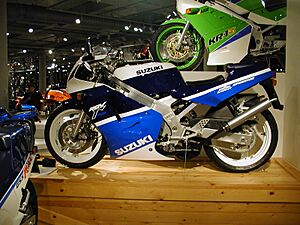
- X6 Hustler (1966-1968): Known as "the fastest 250cc motorcycle in the world" at the time.
- T500 Titan (1968): A powerful 500 cc motorcycle that became Suzuki's main model.
- GT750 Le Mans (1971): The first Japanese motorcycle with a liquid-cooled engine, nicknamed "Water Buffalo."
- TM400 Cyclone (1971): A motocross bike designed for racing.
- RM125 (1975): A successful motocross bike that led to the future RM series.
- RM250 (1982): A redesigned motocross bike with a powerful liquid-cooled engine.
- RG250 Gamma (1983): A "race replica" sport bike with an aluminum frame and powerful engine.
- RG500 Gamma (1985): Similar to the RG250 but with a larger engine.
- RGV250 Gamma (1988): A road-racing replica of Kevin Schwantz's GP race bike.
Four-stroke Engines
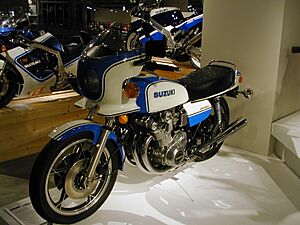
- GS series (1976): Suzuki's first four-stroke motorcycles in 20 years.
- Katana (1980): A motorcycle with a revolutionary, sharp design inspired by a samurai sword.
- GSX-R750 (1984): One of the first modern "race replica" sport bikes, known for its light weight and powerful engine.
- Intruder 750 (1985): Suzuki's first Japanese "cruiser" motorcycle, designed for American riders.
- GSX-R1100 (1986): A larger version of the GSX-R750.
- Suzuki GSF1200 Bandit (1996): A powerful sport touring motorcycle known for its versatility.
- DR-BIG (DR800S) (1990): An off-road motorcycle with the world's largest single-cylinder engine at the time.
- Suzuki RF Series (1994-1998): Sport touring motorcycles with different engine sizes.
- TL1000S (1996): Suzuki's first sport bike with a V-twin engine.
- GSX-R600 (1997): A smaller version of the GSX-R750.
- Hayabusa (1998): Suzuki's flagship sport bike, one of the fastest production motorcycles.
- SV650 (1999): A popular "naked bike" (without much bodywork) that was also offered with a fairing.
- GSX-R1000 (2000): The largest model in the GSX-R series.
- Burgman 650 (2002): The largest scooter in the world at the time, with an electrically controlled automatic transmission.
- Choinori (2002): A very lightweight and inexpensive 50cc scooter.
- Boulevard M109R (2006): A powerful V-twin cruiser with very large engine pistons.
- GSX-650F (2008): A sport touring model with ABS brakes.
- Suzuki DR125: A 124cc four-stroke motorcycle.
- DL-650 V-Strom: A motorcycle designed for both on-road and off-road riding.
- GSX-250F Across (1990-1998): A small sport touring motorcycle known for its practical storage space.
- GSX-R250 (1987-1994): A 250cc racing bike designed for the road.
Other Power Sources
- RE5 (1974): The first Japanese motorcycle with a Wankel rotary engine, making it unique and collectible.
- Burgman Fuel-Cell Scooter (2011): This scooter uses an electric motor powered by a hydrogen fuel cell, with only water as an emission. Suzuki is working to sell this scooter to the public.
Suzuki Concept Motorcycles
- Falcorustyco (1985): A concept showing future motorcycle technologies, like a frameless body and hydraulic drive.
- Nuda (1986): A two-wheel drive prototype with power steering and a carbon fiber body. Its ideas influenced the Suzuki Hayabusa.
- B-King (2001): A powerful concept motorcycle with a turbocharger. The production model came out six years later.
- G-Strider (2003): A mix between a scooter and a cruiser, with an electrically controlled automatic transmission and adjustable parts for comfort.
- Stratosphere (2005): A prototype with a unique 1100 cc six-cylinder engine that was very compact.
- Biplane (2007): A concept designed to feel like flying an airplane, with an open design and a V-four engine.
- Crosscage (2007): A fuel-cell concept motorcycle that combined a battery with a compact fuel-cell system for clean power.
- Gemma (2007): A "full-flat 2-seater" scooter prototype designed for intimacy between rider and passenger.
- Recursion (2013): A turbo parallel-twin middleweight concept motorcycle.
Suzuki All-Terrain Vehicles (ATVs)
Suzuki makes many different ATVs, also known as "quads" or "four-wheelers." Here are some of their models:
- Trail Buddy 50 (ALT50)
- QuadRunner 50 (LT50)
- QuadSport 50 (LT-A50)
- QuadSport 50 (LT-Z50)
- QuadSport 80 (LT80)
- QuadSport 90 (LT-Z90)
- ALT125 3x6
- LT125D 4x6
- QuadRunner 160 (LT-F160)
- ALT185 3x6
- LT185
- LT230
- QuadRunner 250 (LT250E)
- QuadRacer 250 (LT250R)
- QuadSport 250 (LT250S)
- QuadSport 250 (LT-Z250)
- Ozark 250
- King Quad 300
- LT300E
- Eiger 400
- KingQuad 400
- LT-Z400
- LT-R450
- QuadRacer 500 (LT500R)
- KingQuad 500
- Quadmaster 500
- KingQuad 450
- KingQuad 700
- KingQuad 750
Suzuki's Sports Sponsorships
Suzuki supports many sports events. They are a big sponsor of winter sports like luge, biathlon, and cross-country skiing. They were also the main sponsor of the ASEAN Football Championship (called the AFF Suzuki Cup) from 2008 to 2020. Suzuki has also sponsored football clubs like Milton Keynes Dons in England, Torino in Italy, and Korona Kielce in Poland.
Images for kids
-
The Suzuki plant in Esztergom, Hungary
-
Maruti Baleno Rally Car in 2005
-
Suzuki RGV250Γ at the Barber Vintage Motorsport Museum in 2006
-
Suzuki GS1000S at the Barber Vintage Motorsport Museum in 2006
See also
 In Spanish: Suzuki para niños
In Spanish: Suzuki para niños
- List of Suzuki engines
- Suzuki World Rally Team


